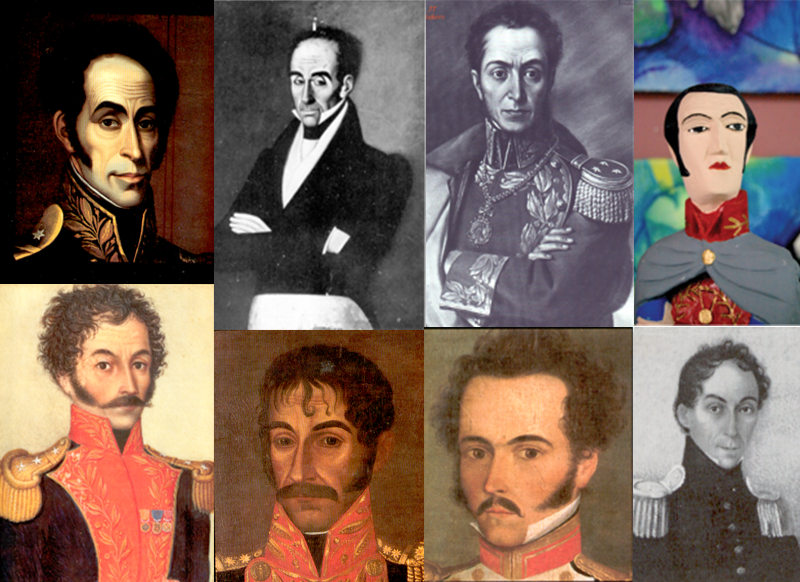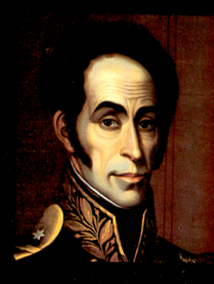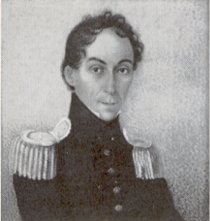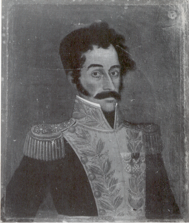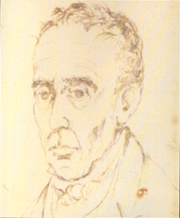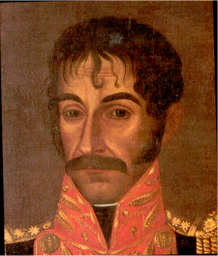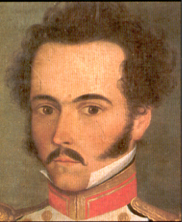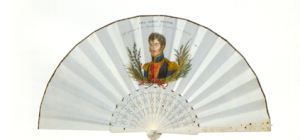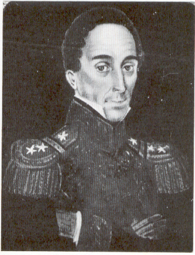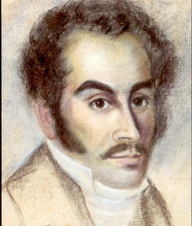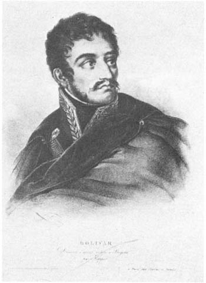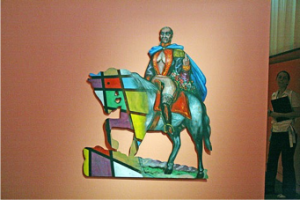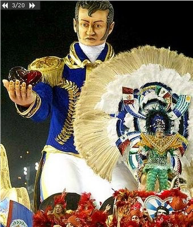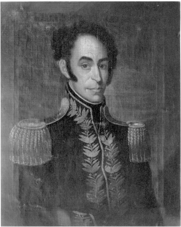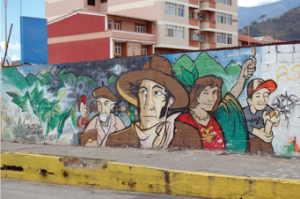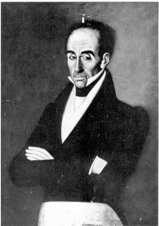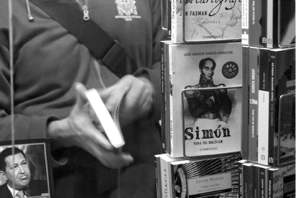Elizabeth Marín Hernández
University of Los Andes,
Merida, Venezuela.
History seeks to reveal the forms of the past, its memory models them, a bit like tradition does. The concern of the first is to put order, the second is crossed by the disorder of passion, emotions and affections
Joël Candau
The image that haunts us.
A face shows in our memory the presence of contents and meanings that are difficult to articulate with reality. It has always been there, haunting us, following us, marking the routes of an identity based on the origin of a handled semblant in the interiority of sublimated feelings by an apprehended heroism through the redundancy of an image seen and assumed in the continuity of a certainty that awaits a way of proceeding.
A face that carries with it a social insertion of collective subjectivities, of the places of evocations, and that manifests the cult of a new religion capable of “making virtually ungraspable the real personality of its object, to the point that after some time the latter seems to lack interest since in fact it is replaced by the personality ad hoc shaped by the cult”.
In this sense the face is modified within zones of multiple codification, of values and of ambiguous discourses, by taking independence with respect to the real socio-subjective body with which it is connected; because everything passes through the presence of the limit created on the screen represented in the skin, in the map that furrows it as a symbolic formation, as a replacement of the internal self visualized in the portrait and in the system of conventions that allow us to recognize it. However, something is found beyond the superficiality of the screen that we observe, of the formal elements that conform it and of the meanings that have been intended for us.
An image, a portrait, a face that makes it possible to know an era, its mentality, its memory and the distortions that can be caused on it by those who use the screen. Once the face has been emptied of all original reference, all that remains are holes in the discourse, far from the first countenance, the first name, and close to the handling of the subjectivation of power in the face of a hero/father, the cohesive force behind the profound differences of a society such as Venezuela’s.
From the image that pursues us emerges the face of a screen inscribed and re-inscribed thousands of times, a herd of consciousness, passion and redundancies – as Deleuze and Guattari wrote – of a singular face, that of Bolívar, subject to the continuous elaboration of meaning in different temporalities. His face is added to the center of speeches of the Father of the Fatherland, of the Apostle of Freedom or in exalting narrations of a quasi-divine personality.
For the study of the human Bolivar, the plastic reproduction of his noble face would serve as a foundation stone for criticism and would not be seen as daring and even irreverent statements about the genius or exceptional aptitudes that made up the personality of the maximum progenitor.
Melancholic lithographs present us with a man with an oval face, a square forehead and full eyebrows, an austere and reflexive appearance, a moderately aquiline nose, an exaggeratedly angular jaw and deep black eyes, perhaps too close together (…) this is the Liberator Bolivar: a man of hard and long struggle, an indefatigable horseman, a protagonist capable of multiple achievements, miseries, selfishness, heroism and histrionics that one can imagine; a man of numerous counselors and great resistance; now dead and gone; of whom, except for that melancholy lithography, educated people of Europe know nothing. But who can deny that he flew swiftly from one end of the world to another, often in the most desperate way, followed by a wild cavalry covered with blankets, ready to fight the war of liberation ‘until death’?
The intentionality symbolized in Simón Bolívar’s images leads us to a study positioned in the discourses of the manipulated face as an abstract machine of production of screens that sprout, (…) when you least expect them, in the course of a numbness, a twilight state, a hallucination, an amusing experiment (…) there is nothing to explain, nothing to interpret (…) Here nothing looks like a face and yet faces are distributed throughout the system, the features of face are organized. And yet, even this abstract machine can be perfectly carried out in something other than faces; but not just any order, nor without necessary reasons.
Hence, Bolivar’s face manifests a cult distributed in the collective consciousness of the Venezuelan through multiple historical articulations, marked by the integration of the diversity of faces, which guide the construction of places of memory in which new socio-cultural frameworks are dislocated, destroyed “o, The modes of memorization – of the visualization of the screens – of a given society and its members, are simply modified to adapt to the new social frameworks that will have to be established” within a complexity of memories or image archives, which refer to the State, the Nation and politics.
The cult of Bolívar is a psychosocial phenomenon that expresses a conjunction of factors and historical circumstances that demand a serene and critical evaluation. By this I mean that in its origin are facts and authentic needs.
Thus, in the origin of the phenomenon there are two authentic facts: the existence of a hero (…) and the presence of a conjuncture: the spontaneity of the popular cult to Bolívar and the requirements of the process of definition of the Venezuelan national conscience.
Equally at the origin of the phenomenon is a sociohistorical necessity: that of reestablishing the power structure in conditions of accentuated weakness of the dominant class, of a very low degree of social integration and of the persistence of great structural obstacles such as the absence of national structures, incommunication, generalized illiteracy, etc.
The cult of Bolívar and the different emotional states represented by his image would mean how to learn with the help of images (…) a story worthy of reverence. Because reading teaches the reader, the images teach the illiterate, whom they can only perceive with their eyes, since in the drawings the ignorant see the story they should read, and those who do not know the letters discover that, in some way, they can read. Therefore, especially for ordinary people, pictures are the equivalent of reading.
In this sense, Bolívar and his images will function in the midst of the fragmentation of Venezuelan society, managed by the precariousness of its institutions, which will manipulate the cult from pseudomistic and cohesive perspectives of collective subjectivities within an archive operated and consolidated by high pontiffs, as Elias Pino Iturrieta states in arguing the following:
The usual explanations about the cult of Bolivar find the origin of the phenomenon in the liturgy promoted by the Venezuelan governments after the dismemberment of Colombia. This is a well-founded analysis, if we remember how the instructions for the tabernacle factory left the palace at that time and how President Antonio Guzmán Blanco was, from 1870 onwards, one of the most determined architects. At least since 1842, when the Liberator’s ashes were returned to Caracas with pomp due to the orders of President José Antonio Páez, a clear relationship can be established between this kind of civic religion and official actions
The cult evidently needs faces, screens, visual images capable of building devotion towards a tangible construction of the discourse on the heroism of Venezuelan identity, which manifests its imaginal equipment through the continuous repetition of founded faces by obtaining and maintaining power in terms of control over the definition of the past, and the
(…) approach to memory practices as hegemonic memories and dissident memories embodied in voices, narratives, texts, images, objects and actions generated in spaces of confluence and confrontation, of domination and subordination, of struggle and hybridization between diverse and disparate inter- and intra-societal groupings.
The collective equipment of Bolivar’s face presents us with an abundant iconography in which the body and its attitudes are left aside before the persecutory presence of the screen of a physiognomy emptied of all subjectivity, to be filled by the multiple signifiers of a civic religion, in need of the construction of an imaginary capable of identifying it, that somehow amalgamates it in pursuit of the places of memory devised in evocation and repetition as neurotic symptoms of oblivion.
The continuous realization of portraits of and about Bolívar, show us the usual solution of the construction of a nationalist, religious and particular ideology, generated through the image of a subject unoccupied of his particularity, to make it transcend towards the incarnation of values and behaviors worthy of imitation. This idea is not new in the Western plastic tradition, because since “the classical antiquity a series of conventions were already established for the representation of the ruler as a hero or as a superhuman character”.
Rome
The tradition of the plastic arts, from the Roman art indicates us the visuality of exceptional individuals, because as heir of the Hellenistic tradition,
(…) he produced a large number of portraits related to the custom of preserving, both in the official sphere and in the home, the memory of the faces of characters whose memory was considered essential to maintain. In official art, the portraits of rulers and high officials favored a memory that in many cases had the virtue of evoking throughout the centuries paradigmatic figures, whose intangible presence guaranteed those personality and performance features that were valued under a positive sign through time.
In these traces of memory the face acquires a determining importance, since all its recognition passes through it, and the abstract machine begins to walk at the moment in which the face is endowed with meaning by the discourse of the time that welcomes it, observes it and fills it with redundancies in the midst of the transience of a reality dominated by the wrapping of memories of power and subaltern memories “open to the dialectic of memory and amnesia, unaware of its successive deformations, vulnerable to all uses and manipulations, susceptible to long latencies and sudden revitalizations”.
Bolivar’s face has gone through a complex world of representations and displaced personifications, from the equestrian portrait to the sick and depressed hero, evidenced in the diversity of the visual discourses, conceived in the equipment of the places of memory, directed towards the search of an identifying potentiality under the eagerness of different political regimes that manage the abstract machine and in which, as Deleuze and Guattari argue
(…) the machine must precisely allow and guarantee both the omnipotence of the signifier and the autonomy of the subject. They will nail you to the white wall, they will sink you into the black hole. This machine is called the rostrity machine, since it is the social production of the face, since it performs a rostrification of the whole body, of its surroundings, of its objects, a landscaping of all the worlds and environments. The deterritorialization of the body implies the reterritorialization of the face; the decoding of the body implies the overcoding of the face (…) The face is a policy.
Hence, the faces represented only reflect “social illusions, not so much ordinary life as a special representation of it”, which therefore explains the transformation or stabilization of a visuality marked by the aspect of a character that shows the signifiers of mentalities, which are adjusted to the precise continent detached from the body, mitigated, exposed to satiety from his youth to the decrepitude of the sick body, represented in the laceration of the disease marked on the map that leaves us the last vision.
The face machine decodes the corporeality, overdimensioning the physiognomy of the wall/face in which the signifiers of the wall/map are united, indicating the peculiarities of the mitified countenance of an existence; only object pierced by the discourse of a heroism trapped in the names that hold the mark of the real, built by the gazes of power in their diversity and manipulation, and where the face of the father possesses so many names, so many representations, that have sealed in them the disjunctions between the semblant of a face and what its subjectivity can inscribe in the real as a simulated image.
The descriptions of the face that concern us exceed the need to capture an ideology capable of narrating our particular mythography, since in that face-map the body succumbs to the screen, full of holes of meaning from the discourses in which absolute deterritorialization becomes evident -as Deleuze and Guattari- since
(…) the head is made to come out of the stratum of the organism, both human and animal, to connect it with other strata of meaning or subjectivation – where – the political power that passes through the face of the boss, banners, icons and photos, even in mass actions (…) In all these cases, the face does not act as an individual, individuation is the result of the need for a face. What counts is not the individuality of the face, but the effectiveness of the encryption that it allows to perform, and in which cases. It is not a question of ideology, but of economy and organization of power
In this sense, Bolivar’s face, in its diverse representations, expresses narratives that escape through the black holes of the screen built by the multiple discourses of a face visualized from the details that manage to speak to us of the use of the mustaches, of the color of its skin, of its possible afro-venezuelan features, only with the purpose of showing us a heroic subject product of the new American world which possesses a physicality impossible to grasp.
Because “there is no painter who is capable of capturing his expression. There are no two portraits of the Liberator, in his abundant iconography, where one resembles the other. There are paintings even made by renowned painters, where his physiognomy is unrecognizable”.
Authors like Alfredo Boulton emphasize the importance of the iconographic study of Bolivar’s images, to determine the times in which he used or did not use moustaches, in which his youth was manifested or the portraits in which his heroic condition is available, however, the wide range of faces activate the face machine in its significant becoming, beyond the first state of formal visualization of the images.
Bolivar’s faces exhibit white walls pierced by the political discourses that manipulate them, in the midst of an economy of culturally and socially produced elements, within a semantics capable of activating the devices that make up the screen-map, in which they situate the gazes that describe him, and that position us in the readings of an existing face in different realities, to conform a face that cannot escape from itself; because in it one experiences the becoming of an admiration or a contempt, that goes beyond a countenance centered in a polarity of forces that fragment it and in which the face becomes a construction as it is evident in the descriptions of the text Iconography of the Liberator by Enrique Uribe White:
Ducouray -1813- “… great whiskers and sideburns”. (…) Roberto Proctor, Narrations… translation from Aldado, Buenos Aires, 1920 says, on September 1, 1823… “He has big moustaches and frizzy black hair”. O’ Leary, Bolívar y emancipación de Suramérica, Madrid s.a., Volume 1, p 580, says: “… the sideburns and moustaches, blondes, I shave them for the first time in Potosí in 1825”. A testimony that deserves full faith; note that O’Leary says for the first time, which he must have known very well, since in all those years he did not separate from the Liberator’s side
Descriptions such as those mentioned lead us through the path of the performance of a screen, explained as a map of construction and reflection of a culture desiring the activation of the face in the midst of states of meaning, capable of generating new lines of escape from the face of a Bolivar, which selects or eliminates the visualizations that are codified on it; For the face appears in the interiority of the forces that converge towards the ambition of producing an ideology in the collective experience, which begins – as Pino Iturrieta writes – within a great national showcase, which saw the light of day in the National Exhibition organized by Guzmán Blanco in 1883, in which the concept of progress related to officialism and Venezuelan patriotism was summarized.
One of its rooms contains objects that belonged to Bolivar: a handkerchief, a shirt, a pair of socks, a cloth panty, a desk, some epaulettes, a pair of spurs, etc., and a relic extracted from his body: “The phosphatic limestone concretion found by Dr. Reverend in the Liberator’s lungs”. On the walls of another room hang some oil paintings that will become essential pieces of the republican iconography: The last moments of Bolívar, by Antonio Herrera Toro; and The signature of the Act of Independence, by Martín Tovar y Tovar
Among objects, relics and works of art, the face of Bolívar becomes omnipresent within the infinite possibilities of the abstract machine of the face, bearer of the protective screen and organizer of the discourses in which the contradictions of the signifiers, of the connections that provide the necessary substances for a historical discursive subject chosen by the agency of power, are patented; understood not as a hegemonic state, but in the particularity of its mechanisms of insertion within the social body, where the forces of signification and resignification of the machine of rostrity act in a continuous and fragmented way, to link up with the emotional places of memorization of the social collectives.
In this sense, “power, in its permanent, repetitive, inert, self-reproducing aspect, is nothing more than the overall effect that is drawn from all these mobilities, the enchainment in each one of them and tries to fix them”, while Bolivar’s face appears in complex strategic situations in the midst of given societies -as Foucault would write-, in the face of the need for a political-cultural equipment to which he does not oppose resistance but rather manifests it,
A hermeticism agreed upon by the majority and unconsciously. (…) the goodness and the evil of the próceres are already codified. There is only one “sidereal man”, a cast of blessed and a crowd of villains consuming themselves in the republican underworld (…) If from homes and schools they have been trained as altar boys of a national celebration, they react like simple people without their diplomas or their talent weighing on their behavior. They are part of the militant church of San Simón as the neighbor without lights. (…) Perhaps they feel that they were not born to become iconoclasts, a decision that no one would be able to censure if we already know how society needs a hero.
And a hero is always the same. He has to maintain his gigantic stature until the consummation of the centuries. He cannot have defects or weaknesses as is the case with all the world’s heroes. No one can equal his deeds because society considers them superhuman, imitating the example of all societies in the universe in the face of the works of their heroes.
He will go beyond the domestic confines and occupy stellar places in other latitudes as his intrinsic entity deserves. (…) Just as people need it for an explanation of their birth, so must they suffer its despotism. People must know that they will always be there for veneration and must participate in its mysteries.
Bolivar’s face and his abstract machine are transformed into the agency of a symbolic power, capable of coloring the social body that equips his imaginary through the representational continuum of a face full of repetitions, redundancies, and an established cult within a social economy that starts from the appreciation of the minimum detail of the sidereal man as a producer of meaning or stabilizer of the effects of division of the Venezuelan social body.
Eyes/ Black Holes
The abstract machine of the face is manifested in the white wall arranged for the realization of a complex cartography, full of holes that escape in the various instances of a look that does not look at us. Absent and emptied of its own subjectivity, the face enunciates a new codification in which the eyes function as the center of an alien discourse.
The history of the heroic face drags all the significant surfaces and volumes of the stories that have built its political agency, in the midst of the desire for deterritorialized individuation that seeks to connect with other states of collective significance.
Bolivar’s face manifests its origin from
(…) of the subset of a social body crossed by the mark of the socius, by the tattoos, the indications, etc. This body does not have individual organs: it is itself crossed by the souls, by the spirits that belong to the group of the collective arrangements (…) the social arrangements, collective equipment that awaits a certain normalizing adaptation
Hence, the face and countenance of the hero is pierced by the suspicion of a standardizing equipment of collective emotions, expressed through the eyes, which like black holes arranged on the screen refer us to other stories, full of superhuman sensitivity, not written by the individual’s subjectivity but by those guardians of the archive of the hero’s images.
Simón Bolívar: Antonio Meucci (1830)
Cartagena
The black holes send us to a diversity of vanishing points before the gaze emptied of subjectivity, they only manifest themselves as spaces of redundancy of limit figures, where the white wall of the face in the middle of a confused semantics of segmented policies shows a look beyond our corporeality and subjectivity.
The most notorious and constant thing in Libertador is the brilliance of his gaze. Innumerable people who had the opportunity to know him are aware of this. “His retinal eyes were continuously shining, showing the whole range of feelings and emotions that this man with an open heart was capable of”. His two main distinctive features,” writes Paez, “consisted in the excessive mobility of his body and the brightness of his eyes. Boussingault is of the same opinion. Even in the most peaceful circumstances, such as receiving a diplomatic representation, his black eyes moved with singular vivacity: scrutinizing his interlocutor with a deep gaze, which he quickly abandons to plunge into ostensible abstraction from which he returns and to which he returns amidst intermittent spasms. (…) In anger, in which one gradually acquires it, it is not brilliance that their pupils exhale: it is the fire of a basilisk that increases by the storm of movements that shook them (…) When sadness abates him, there was no more painful look than his, nor that showed with more diaphanousness what melancholy can do to a man, the other great feeling towards where that mutant, prodigious and passionate affectivity is polarized. When he arrives to anger, love or joy, nothing better than his eyes to express it
It will then be said that the black holes of the white screen articulate and set in motion the abstract machine of the face by completing the deterritorialization of the emotions that surround the original subjectivity. The accounts of that gaze in continuous transformation empty the black hole of the original eye, to fill it with diverse horizons of temporal and continuous significance, becoming a gaze that has been taken over by the production of faces in which it does not count
(…) the individuality of the face, but the effectiveness of the encryption it allows to perform, and in which cases. It is not a question of ideology but of economy and the organization of power. (…) we do not say that the face, the power of the face, generates power and explains it. On the contrary, certain agencies of the power to produce faces, others do not.
The presence of power passes, in this sense, through the continuous production of images and black holes that pursue us within the transit of the significant intensity of the individualization of the places of collective memory, built through the generation of screens in which our black holes bounce off the concrete face of a Bolivar, which adjusts and misadjusts depending on the screens established by power, in the midst of the use of the face as a mode of reproduction “not of the communal, but of the identifiable uniqueness, not of the species but of the individual. These singular representations have never been, nor are, universal”.
The representation of individuality appears in the manifestation of the myth that embodies the assent or rejection of our particular stories, where the eyes of the face show us a look that crosses the souls of Venezuelans, because our cult is offered to a hero/father “endowed with great strength and displays great activity, his look has an extraordinary intensity, and is of a benevolence that does not imply weakness”.
In this way the eyes, like black holes on the screen, extend the presence of an unknown hero in his real face, only the multiple descriptions and narrations of a look far from any initial content.
The black holes unfold within a white screen used in every sense -as Deleuze and Guattari- to produce the significant units of a face handled and manipulated within the exaltation of the desires of a representation that comes from the great hero to the purest form of desacralization as manifested in Bolívar by the Chilean artist Juan Dávila in 1994 or the carnival group presented by the School of Samba ‘Vila Isabel’ at the Rio de Janeiro Carnival in Brazil in 2006.
The multiple representations of Bolivar, lead to the continuous resignification of a screen arranged to make rostrified. Descriptions that speak to us of the father/screen, in which the forms of representation reconfigure and divert a face that has been enabled to maintain and at the same time subvert the discourse that encloses it.
Hence, the face and its holes, meet the subjects who wish to fill them with signifiers, turn them into an abstract machine of rostrity before a social body eager for meaning and a presence of power that imposes signification and subjectivation within a given form of representation.
In this sense, Bolivar’s rostrity becomes a means of ordering the collectives, as a symbolic equipment of a gaze produced in the emptying of his eyes, to appear as the visuality of a heroic cult that leads the absent subject to the domination that moves from words to the continuous visual presence, elaborated through the representations and the consciences of the collectives, beyond the influence of the written word. Black holes in which the spectator avid of the cult rehearses his desire.
Black holes are not mirrors in which we look at ourselves to recognize ourselves. They enclose a segmented game of unbridled historical and cultural forces, in which the organization of the forms of symbolic power are posed, but these are not ideological structures, but emotional ones, since in them one recognizes the production of a “revealing structure of a new conception of the subject, that of a divided subject. Since it is not only at the juncture of the imaginary and the symbolic that the spectator is situated. In the imaginary, the painting is an “effect of the real”, it induces in the subject a loss of references where he or she usually engages his or her certainty”.
The face machine sends us the subject, divided between the reality of a face and the discourses that have been generated about it and where the emotional complexity of the black holes is manifested, in which we propose the permanent drift of a visual historicity filtered by the political narratives to which we are tied.
Hence, the “real effect” is glimpsed through an ordering will on the visuality of a face impossible to be observed in detail in its multiple significant redundancies, since imaginary faces fall before the symbolism of power manifested in its permanent use and where the subjective real of Bolivar’s original face
(…) is excluded from the register of appearances and in the whole extension of the perceptive body, it is precisely the only object from which the subject will be sure not to be able to distinguish. From then on, more than in the search for something to see, what stalks the subject will never be in his line of sight, never present to the invisible. The visible is better than the screen.
To this indefinitely repeated effort to see ‘beyond’ comes the gaze. This stops the search for the subject that ‘wants to see’: The object of the gaze is then valid as a symbol of the lack (…) it symbolizes the central lack of desire.
The gaze that crosses us goes beyond our deep concerns in the midst of the discourse of the face that is alien to the original subjectivity, since what is sought is an expression as a unique form of production of meaning in the face of the diversity of social elaborations that the machines of the face manage to represent.
The black holes show us the unique gaze of power, which seeks to cancel any action desiring representation. Because alteration appears from where my screen does not look but is seen through the politics of the face as a means of exemplary sublimation.
The image that pursues us constitutes the policy of emptying the subjective references of history of a particularity that has been erased and manipulated, in the midst of the experimentation and enchantment of the managers of the collective equipment, because there the myth is served from adulation to the present rejection on a screen that has been read, written or figuratively a thousand times, and in which the black holes bounce in the interiority of their excesses, in some place located beyond the eyes with which they look at us and where “The face of the father, the face of the teacher, the face of the colonel, the face of the boss, enter into redundancy, they refer to a significant center that runs through the various circles and passes again through all the segments” that have articulated all their stories.
Hence, the faces become replaceable images according to the discourses that one wishes to present in them or the emotion that one intends to affect in the action of the abstract machine of the face. Because the discourse that has emptied the face uses the screen and the black holes as a place of enunciation of a new significance, where the face is directly related to the different power agencies, which have the need to create the images as a means of social and cultural articulation.
The Impossibility of the Face
The faces overcode the path of the signifiers of the subjectivities emptied of their contents. The face appears in this sense only as a screen, a mask, ready to be filled with other forms of symbolization. Beyond the original gaze, the manipulated and used faces configure a policy from which diverse semiotics composed by the thoughts of others emerge, which set the abstract machine of the face in motion, amidst the pretension of articulating the emotional, mnemonic and symbolic contents of Venezuelans.
The face of Bolívar in its different, continuous and infinite representations manifests the continuum of the deterritorializations of a visual cult that supposes new subjectivations in which diverse layers of meaning are mixed. Hence the impossibility of a gaze, since the manipulation of the screen keeps in itself shreds of the manipulations to which it has been subjected from the sacralization of the face that concerns us until its total desacralization.
An ambiguous discourse for a face machine that pretends to be the symbol of the glories of a nation and that we can equate with the beginning of a new territory characterized by the emotional, in the location of the screen as a face-limit of a reality mobilized between the subjective and the real or in the reproduction of a face that leads us continuously to the dominant subjectivations as changing, as multiple and where
Every collapse has its explanation, but Bolivar appears in the midst of all the rubble. Obviously, the politician in charge is manipulating his thought, but also the disconnection of the urgencies of each time with the ideas of the great man is obvious. His worries born from the wars of independence are not useful for the post-war period, nor for the “dry leather” that one wishes to soften later, nor for a country kidnapped by a tyrant when oil wealth appears, nor to clear up the unknowns of societies that distance themselves from a fierce dictatorship, nor for the “re-foundation” of a society after the democratic period. Just as the facts make evident the twisted handling of the great man’s ideology, they demonstrate in a clear way how little it can serve in the diverse posteriorities.
Bolivar’s face machine has followed the same destiny as his ideas, always present in our imaginary, transforming itself depending on the politics that are installed on its screen and subjective to the black holes that observe us, that capture us in the multiplicity of his representations, where the particularity of each one becomes omnipresent in the experience of a macro-coastal that is everywhere as the central face of the diversity concentrated in him.
The visuality of Bolívar’s face and the performance of his abstract machine, formulate the presence of a politics that is impossible to capture the reality of a society that is manifested in multiple layers of meaning, the politics of the face has accounted for this, But it works by concentrating the thousands of segments of a society avid for a history that has been built on the images of Bolivar, which are accommodated depending on the needs and desires of Venezuelan society, in which hundreds of Bolivar’s faces are crowded in its streets and avenues, in its ministries and schools, on fences and banners; only in order to reach the cohesion of the national myth, where tradition – as Pino Iturrieta writes – “maintains its deity of always, while increasing the confessional strength and the statistics of the flock with the elevation of new inspirers of sublime nature. In accordance with its proverbial detachment the deity will be in accordance with the novelties”.
The unique deity is embodied in the novelty of his faces, multiple faces, micro heads tied to a single and active abstract machine that presents the great virtues of the sidereal man, of the thinking macro head, organizer of a society that inherits the universal conventions of the power of the image of a face with which he identifies and is observed beyond the written word. A face that cohabits with the organization of power in the drift of its politics, and in the need for a visual socio-cultural production that must be decoded by means of the continuous semiotics of the screen and the black holes arranged in the various times in which the machine has been activated.
The face machine manifests intentions, its images have remained there engraved on the canvas, on the marble, the paper, the banner, the flannel, the propaganda in its most diverse compositions from TV to cinema. Printed in our memory archives by the handlers of the screen in their diverse times, from Guzmán Blanco to the Republic to our unbalanced contemporaneity in which the image that pursues us becomes ambiguous, diffuse and even incomprehensible.
The reality of Bolívar’s images and faces show the traces of art, iconography, its visualization and communication, which act as instruments -as Deleuze and Guattari- to draw the life lines of an ambiguous face machine within the real events of the policies that are not clearly produced in the images he shapes, but rather constitute active escape lines that escape from the handling of the face to find new refuges in reality; where the faces of the deity can be read in the midst of a political deterritorialization that removes the faces from all other people’s subjectivation, since getting rid of the faces implies the disarming of all the ideas that have occupied them, in order to build new developments capable of penetrating the walls/screens that are presented and breaking with the black holes that trap us.
- The images used in this article have been extracted from:
Boulton, Alfredo (1992): Bolivar of Carabobo, Caracas, Macanao.
Boulton, Alfredo (1956): The Portraits of Bolivar, Caracas, (n.d.)
- The following have been extracted from:
El Libertador Simón Bolívar: Juan Dávila (1994): http://universes-in-universe.de/car/documenta/2007
Simón Bolívar: Vila Isabel Samba School, Rio de Janeiro, Brazil (2006): www.losblogueros.net/mt-webblog/2006
- The images of Bolivar’s Mural on 3rd Street, Merida, Venezuela, Bolivar (popular size) and the image of Bolivar’s book have been made by Valentina Salcedo, for the research project (H-1124-07-06-B) financed by the CDCHT of the University of Los Andes carried out by Prof.: Elizabeth Marín Hernández.
Bibliography
Boulton, Alfredo (1992): Bolivar de Carabobo, Caracas, Macanao.
(1984): The Iconographic Archetype of Bolivar, Caracas, Macanao
(1957): Iconographic exhibition of the true face of Bolívar, Caracas, Centro Simón Bolívar.
_______________ (1956): The Portraits of Bolívar, Caracas, (n.d.)
_______________ (1964): The Portraits of Bolivar, Caracas, Art.
________________ (1989): Miranda, Bolivar and Sucre: Three Iconographic Studies, Caracas, Italgráfica.
Burke, Peter (2005): Seen and Unseen. El uso de la imagen como documento histórico, Barcelona, Crítica.
Carrera Damas, Germán (1983): “Bolívar: el hombre y su culto”, in: Jornadas de Historia Crítica. La evasora personalidad de Juan Vicente Gómez y otros temas, Caracas, Universidad Central de Venezuela, Ediciones de la Biblioteca.
Candau, Joël (2002): Antropología de la memoria, Buenos Aires, Nueva Visión.
Deleuze, Gilles and Guattari, Félix (2002): “Año ceroRostridad”, en: Mil Mesetas. Capitalismo y esquizofrenia, Valencia, Pre-texts.
(2002): “Micropolítica y segmentaridad”, in: A Thousand Plateaus. Capitalismo y esquizofrenia, Valencia, Pre-textos.
Gartner, Marianna (2000): “The image as a nightmare”, in: Images. Una historia privada del arte, Alberto Manuel (ed.), Bogotá, Norma.
Gnecco, Cristóbal y Zambrano, María (2000): “El pasado como política de la Historia” in: Memorias hegemónicas, memorias disidentes. El pasado como política de la Historia, Gnecco Cristóbal y Zambrano María (eds.), Bogotá, Instituto Colombiano de Antropología e Historia/Universidad del Cauca.
Guattari, Félix and Rolnik, Suely (2006): Micropolítica. Cartografía del deseo, Madrid, Traficantes de sueños.
Foucault, Michel (1991): History of sexuality. 1-the will to know, Mexico City, Siglo XXI.
Herrera Luque, Francisco (2005): Bolívar de carne y hueso y otros ensayos, Madrid, Alfaguara.
(2005): Bolivar en Vivo, Caracas, Criteria.
Manzi, Ofelia (2003): “La Cotidianeidad de una imagen: el rostro de Cristo”, en: Mirabilia 2. Electronic Journal of Ancient and Medieval History, http://www.revistamirabilia.com
Pino Iturrieta, Elías (2006): El Divino, Bolívar, Biblioteca Elías Pino Iturrieta, Caracas, Alfadil.
Uribe White, Enrique (1967): Iconografía del Libertador, Caracas, Lerner.
Vinciguerra, Rose-Paule (2006): “Tu no me ves desde donde yo te miro”, en: Las tres estéticas de Lacan (psicoanálisis y arte), Massimo Recalcati (ed.), Buenos Aires, Ediciones del Cifrado.
![]()

